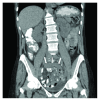Large Bowel Obstruction Subsequent to Resected Lobular Breast Carcinoma: An Unconventional Etiology of Malignant Obstruction
- PMID: 30009076
- PMCID: PMC6020628
- DOI: 10.1155/2018/6085730
Large Bowel Obstruction Subsequent to Resected Lobular Breast Carcinoma: An Unconventional Etiology of Malignant Obstruction
Abstract
Introduction: Breast cancer metastasis to the gastrointestinal tract is rare and mostly limited to case reports which recommend consideration of metastasis when breast cancer patients particularly those with invasive lobular carcinoma present with new gastrointestinal complaints.
Presentation of case: We report a 50-year-old female who presented with gastrointestinal symptoms of nausea and vomiting determined to be the result of large bowel obstruction secondary to rectosigmoid metastasis and carcinomatosis of breast invasive lobular carcinoma. She was treated with diverting loop sigmoid colostomy for her large bowel obstruction.
Discussion: Our case reflects the importance of gastrointestinal surveillance of patients with a history of breast cancer. Current National Comprehensive Cancer Network (NCCN) guidelines for stage I-II breast cancer suggest posttreatment lab and imaging evaluation for metastasis only if new symptoms present.
Conclusion: We observed an unusually rapid disease progression, requiring evaluation of new gastrointestinal symptoms. Assessment for GI tract metastatic involvement should be done as early as progression to symptomatic disease can result in need for further invasive surgery in advanced stages of cancer.
Figures
Similar articles
-
Small bowel obstruction as first presentation of metastatic lobular breast cancer for pilgrim patient.Int J Surg Case Rep. 2024 Jul;120:109855. doi: 10.1016/j.ijscr.2024.109855. Epub 2024 Jun 6. Int J Surg Case Rep. 2024. PMID: 38865947 Free PMC article.
-
Case report and literature review: Metastatic lobular carcinoma of the breast an unusual presentation.Int J Surg Case Rep. 2011;2(8):301-5. doi: 10.1016/j.ijscr.2011.06.010. Epub 2011 Oct 12. Int J Surg Case Rep. 2011. PMID: 22096760 Free PMC article.
-
Presentation of metastatic breast cancer as a large bowel obstruction in an elderly female with resultant diverting ileostomy: case report.Transl Breast Cancer Res. 2022 Oct 31;3:38. doi: 10.21037/tbcr-22-27. eCollection 2022. Transl Breast Cancer Res. 2022. PMID: 38751512 Free PMC article.
-
Obstructive colon metastases from lobular breast cancer: report of a case and review of the literature.Tumori. 2011 Nov-Dec;97(6):800-4. doi: 10.1177/030089161109700619. Tumori. 2011. PMID: 22322849 Review.
-
Synchronous gastric and colonic metastases of invasive lobular breast carcinoma: case report and review of the literature.Ann R Coll Surg Engl. 2011 Jul;93(5):e49-50. doi: 10.1308/147870811X582800. Ann R Coll Surg Engl. 2011. PMID: 21943448 Free PMC article. Review.
Cited by
-
Widespread Metastasis to the Stomach 10 Years After Primary Breast Cancer: A case report and review of the literature.Medicine (Baltimore). 2020 Nov 25;99(48):e22527. doi: 10.1097/MD.0000000000022527. Medicine (Baltimore). 2020. PMID: 33235059 Free PMC article. Review.
References
Publication types
LinkOut - more resources
Full Text Sources
Other Literature Sources
Research Materials
Miscellaneous



